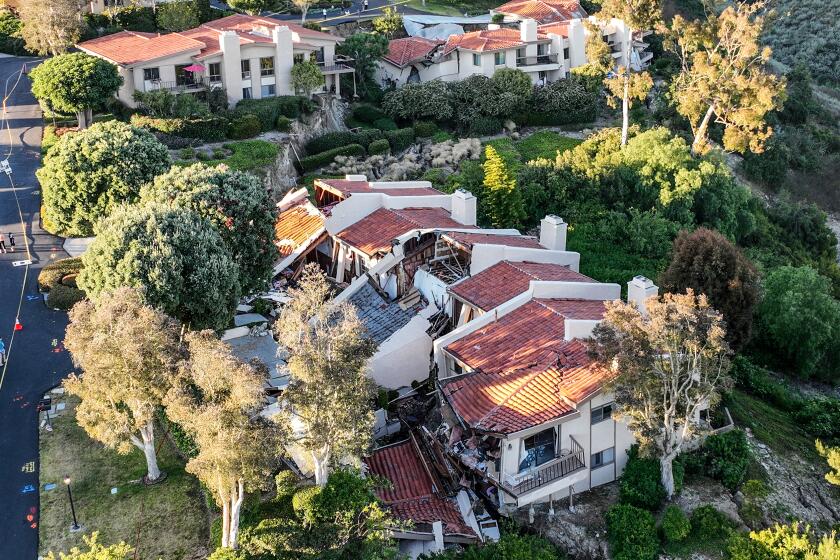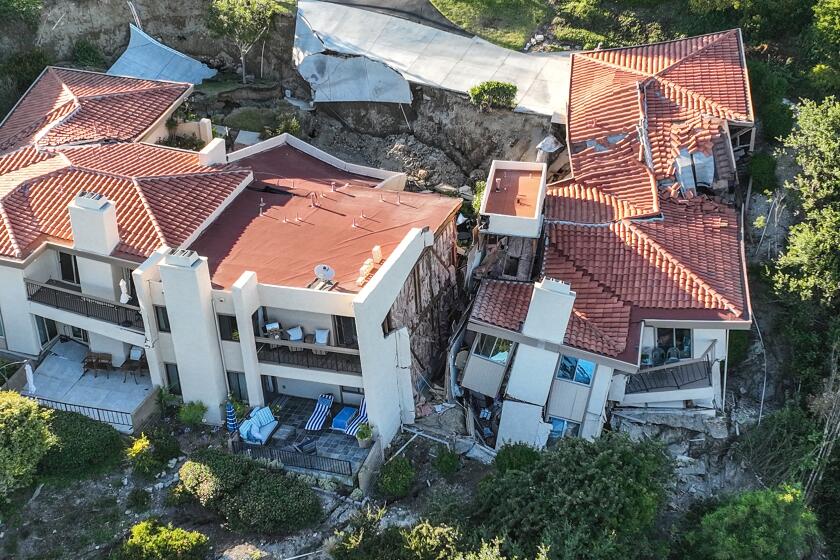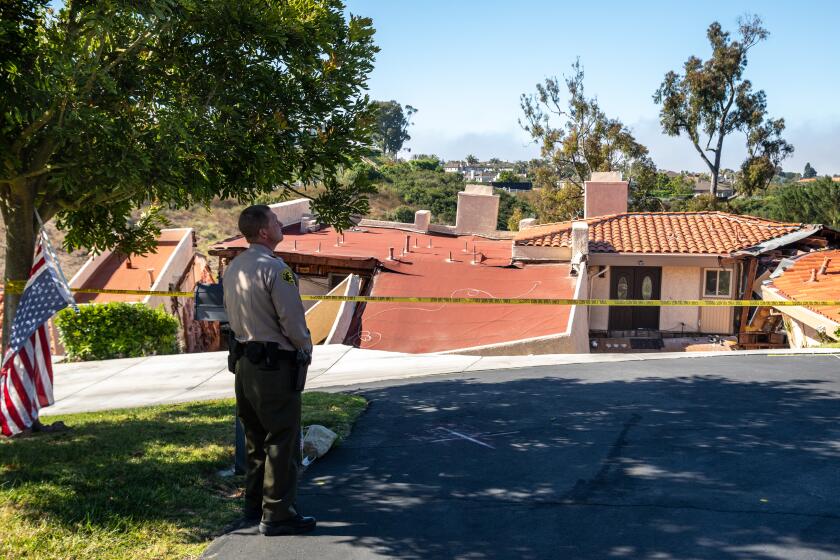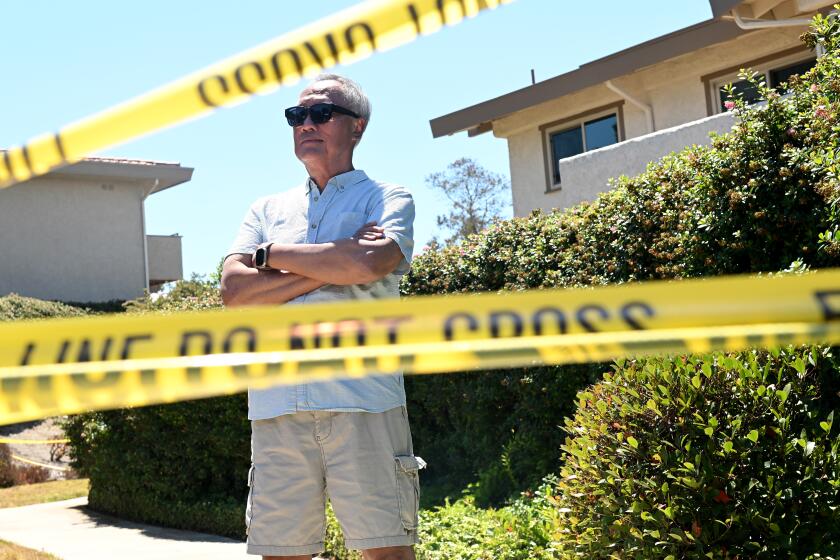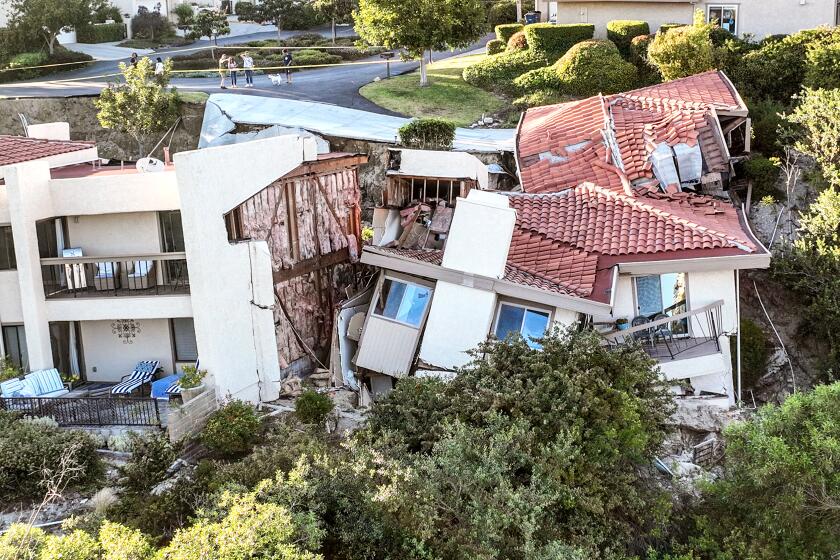Residents raised construction concerns decades before Rolling Hills Estates landslide
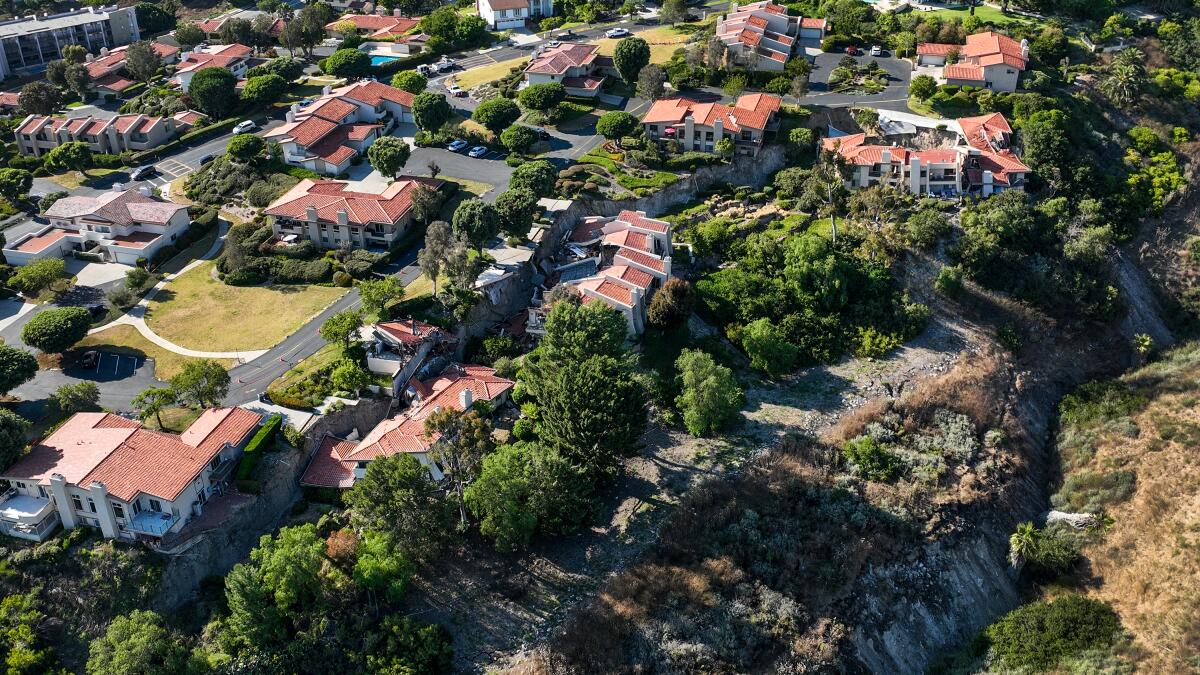
- Share via
Some residents at the Rolling Hills Estates development battered by a destructive landslide raised concerns during the neighborhood’s construction years ago about the potential for problems from water and heavy rainfall, city planning documents obtained by The Times show.
Authorities are trying to determine the cause of the slide, which sent multiple homes slipping down a canyon wall.
In the days since, officials have said rain and groundwater could be key to understanding what caused the land to shift. A geologist hasn’t yet analyzed the site, but officials have said such an expert should be out by Wednesday to begin that process.
But potential problems were flagged more than four decades ago in what eventually would become the Rolling Hills Estates neighborhood.
Questions mount in the wake of the land movement in Rolling Hills Estates, a city that many residents assumed was safe from such disasters.
In December 1978, when the development’s construction was more than two years along, the Rolling Hills Park Villas homeowners board became worried about the progress.
“Now that the development is nearing completion, however, we as homeowners share a rapidly-mounting concern that some aspects of the development fall well short of the minimum requirements of city and county-approved plans,” two homeowners association officials wrote in a letter to the City Council and the county engineer’s office.
They were worried about “improperly poured foundations and footings; inadequate gutters/downspouts; roofing problems” and “grading and drainage — low spots, standing water, soil erosion and decompaction in several areas are already causing problems with very little rainfall.”
The decades-old documents didn’t indicate whether officials or developers addressed the letter, or if there was any credibility to the concerns.
Rolling Hills Estates has declared a local state of emergency in the wake of a landslide that sent multiple hillside houses on a slow-motion downward slide.
Peter Johnson, a spokesperson for the city of Rolling Hills Estates, pointed out that many of these concerns were raised decades ago — and the records The Times reviewed are only the responsive records the city has identified, to date.
“While we do not like to speculate, and our search for records is continuing, the absence of continuing or similar complaints in subsequent years is noteworthy as the HOA Board certainly knew how to get the City’s attention in 1978 and the City demonstrated its responsiveness by agendizing the concerns,” he said.
The records show that City Council officials responded to the homeowners’ questions that month, saying it referred the letter to the engineers in the county Department of Building and Safety, as well as a special city engineer.
Rolling Hills Estates in 1976 approved the permits for a new, multi-unit residential development built on the hills between Hawthorne Boulevard and a small canyon, just a few miles from the ocean.
Records show the construction went forward for the next decade under the watchful eye of city and county officials, who didn’t appear to flag or notice any major issues related to the area’s stability — seemingly no signs that a major landslide would later send a section of those homes falling into the canyon a few decades later.
Seventeen homes on Peartree Lane have been evacuated since the landslide began two weeks ago, a dozen of which have been deemed unsafe to reenter. Many have since collapsed, sliding at least 12 feet below where they once sat along the roadway. Officials say the site remains active.
The Times reviewed more than 200 pages of planning files from the inception of the Rolling Hills Park Villas community, a gated neighborhood that includes Peartree Lane. All the hillside homes affected in the landslide were either townhomes or duplexes.
Although some of Rolling Hills Estates’ planning records referenced reports from geological engineering firms or soil testing, city officials said they have no geological reports from the homes’ original development, or from any subsequent work.
Until last year, Los Angeles County’s Building and Safety Department served as the city’s building department. The Times has requested soil and geological reports from the county, but that request had not been fulfilled as of Monday.
It’s possible other records exist that indicate issues with the land or soil around Peartree Lane. But either way, experts have known for decades that the Palos Verdes Peninsula is prone to landslides, with a long history of such slides — some ongoing — and much of the region considered highly susceptible to ground movement, according to the California Department of Conservation.
Two people were arrested Thursday morning in Rolling Hills Estates after deputies say they attempted to burglarize evacuated homes, then tried to escape into the landslide area.
In 1977, when grading of the undeveloped land around Peartree Lane was underway, a resident adjacent to the construction site complained about the work and said it created cracks in her walls, according to a letter from William C. Stookey, special city engineer for the project, and the developer.
A grading contractor put the resident in touch with an insurance company, which came out to her home and asked her to call the city. But the engineer took issue with the fact that this implied that the city was responsible.
It’s unclear what happened as a result of the letter or whether it was determined the grading created the cracks. There are no additional memos in the letters provided by the city on the matter.
Not long after this, the homeowners association sent a letter stating its “rapidly-mounting concern” about the ongoing development. It requested a walk-through inspection with the city and county to point out the issues. It’s unclear whether that happened.
The homeowners relied on the city and county to review and approve development plans for the townhome and condominium project they contracted to buy.
It’s also not clear exactly where the HOA concerns were focused because the city had not named any of the streets at that time. Coraltree, Peartree and Country lanes were officially designated in January 1979, according to city records.
Just the roof of Weber ‘Wei’ Yen’s home is visible from his street in Rolling Hills Estates. He worries over the mementos he may never get back.
In October 1980, the city had record of two drainage issues in the area. According to notes from a City Council meeting about the development, “there are sidewalks collecting water in the townhouses portion of the area,” the records said. The exact location of that pooling water wasn’t clear, nor how it was handled.
Later that month, in a letter to City Hall, the then-president of Rolling Hills Park Villas Community Assn. wrote about other water-related issues.
“There are at least two condominium units where poured concrete sidewalks are not properly drained and constitute a hazard and at least two common area locations where drainage has not been provided and water from sprinklers and rainfall pools and has severely damaged interiors of residences,” the homeowners board president wrote in an Oct. 27, 1980, letter.
Again, the location of the drainage issues wasn’t clear, nor how they were handled.
The Rolling Hills Estates City Council declared a local emergency and said residents whose homes had collapsed had their “support and sympathy.”
The following year, a resident of Coraltree Lane — which sits opposite Peartree Lane, off Country Lane — wrote to the developer, copying City Hall.
“When I returned from Texas in October and there had been no rain, the water was seeping up through the middle bath downstairs,” the resident complained in January 1981. It also wasn’t clear whether the city or the developer responded, or how the issue was remedied.
Several years later, in 1987, the city’s planning director wrote to an engineering firm asking for further review of a “water seepage” issue on Country Lane — the road from which Peartree Lane stems. He said a different engineering firm had investigated the issue and recommended “additional geotechnical study to determine necessary remedial action.”
Soon after that letter, the City Council approved funds to assist with “accurate soils testing to determine the nature and source of observed water seepage within Country Lane,” according to a March 1987 motion. However, the records did not include whether the study was completed or, if it was, its results.
The most dramatic landslide still affecting the Palos Verdes Peninsula is in Portuguese Bend, an area named after a Portuguese whaling operation, known for its natural beauty and native vegetation.
A dormant landslide complex that shaped the south side of the peninsula for hundreds of thousands of years was reactivated 67 years ago, threatening to destroy homes and infrastructure in the hillside communities that dot the landscape.
The Portuguese Bend landslide was triggered in the summer of 1956 — nearly two decades before Rancho Palos Verdes became a city — when a Los Angeles County road crew was constructing an extension of Crenshaw Boulevard that would run from Crest Road to Palos Verdes Drive South.
More to Read
Sign up for Essential California
The most important California stories and recommendations in your inbox every morning.
You may occasionally receive promotional content from the Los Angeles Times.
